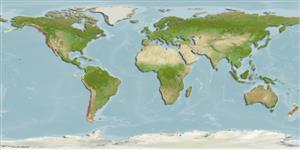Environment: milieu / climate zone / depth range / distribution range
Écologie
marin démersal; profondeur 0 - 49 m (Ref. 2850). Subtropical; 60°N -
Eastern Pacific: Kodiak Island, Alaska to Point San Carlos, central Baja California, Mexico.
Taille / Poids / Âge
Maturity: Lm ? range ? - ? cm
Max length : 25.0 cm TL mâle / non sexé; (Ref. 4925); âge max. reporté: 8 années (Ref. 56049)
Description synthétique
Clés d'identification | Morphologie | Morphométrie
Épines dorsales (Total) : 16; Rayons mous dorsaux (Total) : 14 - 16; Épines anales: 3 - 4; Rayons mous anaux: 12 - 13; Vertèbres: 36 - 39. Dorsal rayed part higher than spinous part. Caudal gently rounded. Anal notched between spinous and rayed parts, well incised (Ref. 6885). Head with scales; one fleshy cirrus above each eye and a pair on the occiput; gill membranes joined, free of isthmus. Body with 7 dark vertical bands. Pelvic fin of moderate length, not reaching the anus (Ref. 48751).
Found in rocky areas, from the intertidal to 49 m (Ref. 2850). Sleeps on the oral disc, leaving the anemone (Urticina lofotensis) by day but returning every night (Ref. 45560). Commonly encountered hovering motionless by divers (Ref. 2850). Feeds on crustaceans, polychaetes, small mollusks and bryozoans (Ref. 4930). Neither anterolateral glandular grooves nor venom gland is present (Ref. 57406).
Eschmeyer, W.N., E.S. Herald and H. Hammann, 1983. A field guide to Pacific coast fishes of North America. Boston (MA, USA): Houghton Mifflin Company. xii+336 p. (Ref. 2850)
Statut dans la liste rouge de l'IUCN (Ref. 130435)
Utilisations par l'homme
Outils
Articles particuliers
Télécharger en XML
Sources Internet
Estimates based on models
Preferred temperature (Ref.
123201): 7.9 - 13.8, mean 10.4 °C (based on 128 cells).
Phylogenetic diversity index (Ref.
82804): PD
50 = 1.0002 [Uniqueness, from 0.5 = low to 2.0 = high].
Bayesian length-weight: a=0.01122 (0.00514 - 0.02450), b=3.04 (2.87 - 3.21), in cm total length, based on all LWR estimates for this body shape (Ref.
93245).
Niveau trophique (Ref.
69278): 3.4 ±0.42 se; based on food items.
Résilience (Ref.
120179): Milieu, temps minimum de doublement de population : 1,4 à 4,4 années (tm=2.5; tmax=8; Fec=112,000).
Fishing Vulnerability (Ref.
59153): Low vulnerability (15 of 100).
Nutrients (Ref.
124155): Calcium = 139 [53, 289] mg/100g; Iron = 1.29 [0.59, 3.09] mg/100g; Protein = 18.5 [16.5, 20.5] %; Omega3 = 0.513 [0.242, 1.348] g/100g; Selenium = 21.1 [11.2, 53.5] μg/100g; VitaminA = 18.4 [6.6, 50.9] μg/100g; Zinc = 0.95 [0.65, 1.46] mg/100g (wet weight);
